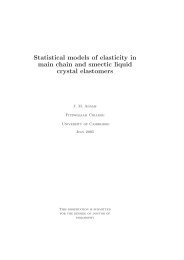Sandra Hopkins Final Report.pdf - University of Surrey
Sandra Hopkins Final Report.pdf - University of Surrey
Sandra Hopkins Final Report.pdf - University of Surrey
Create successful ePaper yourself
Turn your PDF publications into a flip-book with our unique Google optimized e-Paper software.
maximum skin dose to average dose 30 . In another study, results from a TLD array wrapped aroundthe patient were used to measure the maximum skin dose and action levels for DAP were proposed.A first DAP action level <strong>of</strong> 125Gy.cm 2 corresponded to the 2Gy dose threshold for optionalradiopathological follow up and a second DAP action level <strong>of</strong> 250Gy.cm 2 corresponded to the 3Gyskin dose which would require systematic follow up 40 . These values have not been compared in thisstudy but is worthy <strong>of</strong> further work. Indeed, another study demonstrated the need for both operatorand procedure specific DAP values for action levels 41 .5.2 Measuring patient DAP dosesThe old and new labs are from the same manufacturer and any differences are mainly mechanicaland s<strong>of</strong>tware related so it is expected that with the same x-ray tube and flat plate detector and thesame staff group, patient doses should be very similar between the two labs. However, the datademonstrates that there has been an increase in patient DAP dose by 28%. This has been as a result<strong>of</strong> a 35% increase in fluoroscopy dose and a 27% increase in acquisition dose. The mean dose nowexceeds the current Diagnostic Reference level <strong>of</strong> 29Gy.cm 2 and requires investigation and effortsto reduce this dose or justify the need for this higher dose. The mean weight <strong>of</strong> the sample grouphas reduced from 81.3kg to 80.4kg so it is clear that patient weight is not a contributory factor.There may have been a change in technique, however, the data demonstrates that the fluoroscopyscreening time has reduced from 236 seconds to 162 seconds and the mean number <strong>of</strong> acquisitionimages has reduced from 879 to 674. If there has been any change in cardiologist technique this hasresulted in improved technique resulting in reduced fluoroscopy and acquisition and should haveresulted in a patient dose reduction. This demonstrates that the increase in patient dose does notrelate to the examination technique and is related to equipment performance.Both systems have the same detector, however the manufacturer’s specification dose rates haveincreased for the newer system. The older system had field size factors based on image intensifiertechnology with the increase in dose increasing in accordance with the square <strong>of</strong> the field size. Forflat plate detectors a linear relationship has now been employed by manufacturers and the field sizefactor at 25cm and 20cm fields is higher than what had previously been recommended for imageintensifier systems. Detector dose measurements found the new system to have higher detector dosefor both fluoroscopy and acquisition. Additionally, for acquisition there were differences in theamount <strong>of</strong> copper pre-filtration that is automatically added by the system and differences inexposure factors. The significance <strong>of</strong> this to patient dose was assessed by the use <strong>of</strong> a 19cm Perspexphantom to simulate the patient. For fluoroscopy patient doses for the two systems were found to bebroadly similar. However, the new lab had less copper pre-filtration in the beam. Copper filtrationhardens the beam. The x-rays are therefore more penetrating and will result in reduced patient doseat the expense <strong>of</strong> image contrast. The improved latitude and image processing performance <strong>of</strong>36
















